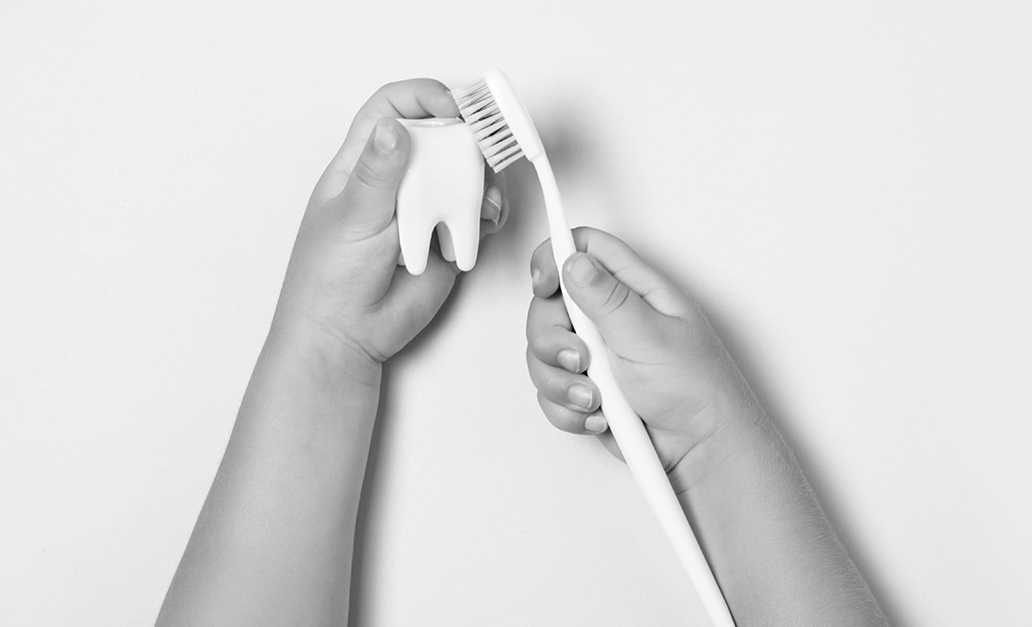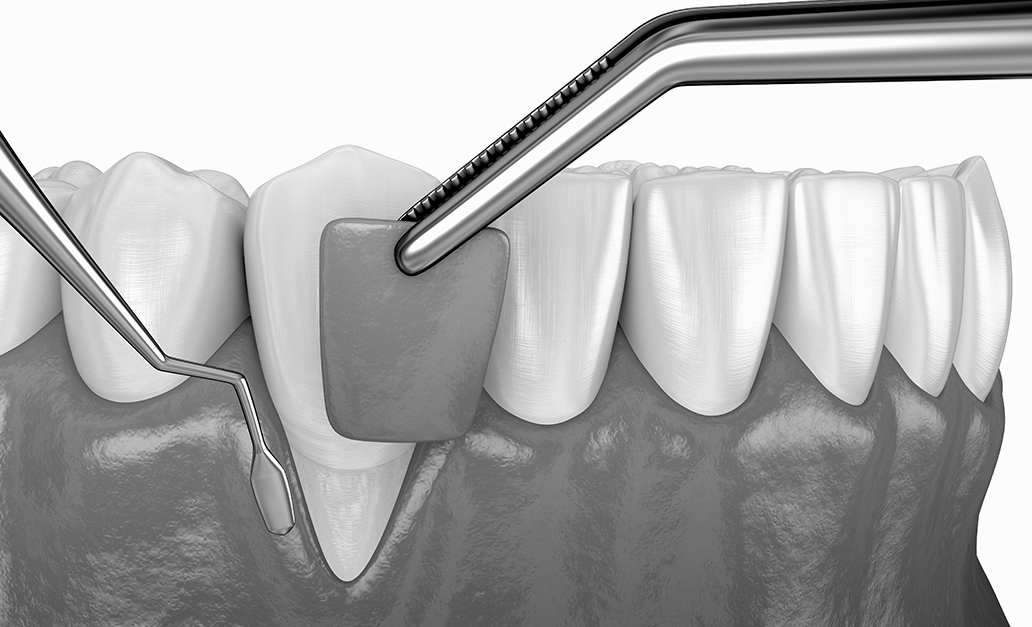No matter your age, maintaining proper oral health relies primarily on prevention. Our team of qualified professionals provides you with access to a wide range of care for the whole family and invites you to take advantage of timely follow-ups. As a complement to cleanings, preventive appointments with complete examinations allow us to detect future issues and to considerably reduce the probability of serious complications.


Prevention is the Best Option

Dental Cleanings and Examinations
Our hygienists have completed rigorous training in oral care, and each of them is a registered member of their profession, without exception. Above all, they are all wonderful people who will welcome you during your next appointment and proceed with the following steps:
- Reviewing overall health
- Taking digital X-rays (if needed and depending on what was prescribed by your dentist)
- Taking pictures using intraoral cameras in order to better visualize the inside of your mouth
- Plaque removal and teeth polishing
- Customized oral hygiene recommendations
Your dentist will then meet with you to perform an oral-dental examination. In order to ensure optimal health, oral-dental examinations should be performed every six months. Together with your dentist, you will set up the best treatment plan to keep your teeth, jaw and gums healthy for life.
Learn more in our FAQs
Tooth Decay Care
We are all familiar with the term “cavity”, but what does it mean, exactly? A form of tooth disease that affects hard tissue, cavities progressively destroy enamel and dentine, which is the layer beneath tooth enamel. If left untreated, cavities deepen and can reach dental pulp, a loose connective tissue richly supplied with vessels and nerves. This can be painful and could possibly require a root canal treatment.
Cavity elimination is a relatively simple operation. It is, however, important to go through with it in order to avoid complications. Commonly referred to as a “filling”, nowadays dental restoration is performed in the vast majority of cases using restorative dental composite resin. This white material comes close to the natural colour of teeth, which makes it an aesthetically pleasing option.
Learn more in our FAQsWisdom Teeth and Tooth Extractions
It is not uncommon for there to be inadequate space in a patient’s mouth. In such cases, when third molars come in, aka wisdom teeth, generally during adolescence, this often creates complications. When these voluminous teeth claim their place in a person’s jaw, they can cause infections or damage neighbouring teeth due to a lack of space.
Wisdom teeth are best removed during adolescence or in a person’s twenties, when healing is at its easiest and pain at its least severe – usually. Extraction is thus often recommended before wisdom teeth even make their appearance in the mouth, in order to avoid issues with adjacent teeth or nerves, as well as problems caused by misaligned teeth. By keeping an eye on wisdom tooth growth, your dentist will be able to determine whether or not extraction is required.
There are other situations that require dental extraction, such as a tooth fracture, a cavity that is impossible to restore due to extreme depth, a tooth that has lost too much supporting bone or a tooth that is too loose in its socket.

Dental Crowns and Bridges
Dental crowns are used to restore teeth that are very broken down, extremely jeopardized or weakened. Crowns provide such teeth with protection, by covering them entirely with a dental cap to better solidify them. In addition to improving masticatory function, this treatment allows for aesthetic improvement. Indeed, the colour and shape of a dental cap may be modified or corrected as desired. Dental crowns are recommended when teeth cannot be repaired using conventional obturation, because crowns are much more resistant.
A fixed bridge is a permanent solution used to replace one or many missing teeth. It is referred to as “fixed” because it cannot be removed by the patient. It truly is worthy of its name, and we often use the image of a real bridge to best convey what the treatment consists in.
Root Canal Treatments
When tooth decay reaches the pulp, which is the living part of a tooth, a root canal treatment is a solution that must be considered. It is a foreseeable treatment for teeth that are deemed salvageable. Root canal treatments allow patients to conserve affected teeth, but these have to be devitalized. Nerves are removed, and the fine channels located in each root of the affected teeth are cleaned. These are then sealed using filling material.
Ideally, teeth on which root canal work has been done should be protected using a ceramic crown, because devitalized teeth are weakened by definition.

Gingival Grafts
For many patients, the prospect of a gum graft can be unnerving. Yet this simple procedure is a far cry from the gravity that is often associated with it in the medical field. A gingival graft would probably be more accurately described as gum added in order to restore gingiva’s original appearance and position.
Gum grafts are performed for various reasons:
- To thicken gingiva that has become too thin over time
- To cover an exposed root (gingival recession, also known as gum recession or gingival atrophy)
- To equalize gingival levels and in this way level out a patient’s smile
Periodontitis and Gum Disease
Gingivitis is a condition that is characterized by inflammation and bleeding of the gums. It may be generalized or localized to certain specific areas. When treated in a timely fashion, gingivitis is reversible. Often caused by dental plaque bacteria, it may be worsened by certain medications, pregnancy hormones and even by too frequent mouth breathing. Adequate brushing and the use of dental floss can help to control gingivitis – however, other adjuvants may be recommended in some cases. Our goal is to treat gingivitis as quickly as possible to prevent it from deteriorating into periodontitis.
Periodontitis is a more serious condition, affecting the bone that supports a patient’s teeth. It is characterized by the detachment of gum tissue surrounding teeth. When the gap created by this separation becomes too large, bacteria form and start to destroy the supporting bone. These gaps are called periodontal pockets. Calcareous deposits harden within these pockets, forming what is called tartar. One way to imagine dental tartar is in terms of pebbles stuck in one’s shoe. We all know how irritating that can be. Having tartar on one’s gums can give a patient that same feeling. Periodontitis cannot be cured – it can, however, be kept under control.

Jaw Joint Treatments
Many symptoms can indicate that a patient is experiencing problems related to their jaw joint, also referred to as TMJ, short for temporomandibular joint. Difficulty masticating, swallowing, speaking or yawning, as well as chronic headaches can indeed come as a result of a jaw joint disorder. If that is the case with you, feel free to discuss it with your dentist, who may proceed with an assessment of your teeth and jaw.
And if a jaw joint issue is in fact diagnosed, your dentist will suggest various solutions depending on the nature of your problem and in order to relieve any pain or discomfort you may be experiencing.
Mandibular Guide Flange Prostheses
Nowadays, bruxism, the grinding or clenching of teeth, is very frequently observed. Often done unconsciously, people have a tendency to clench and grind their teeth. This can lead to muscular and joint pain, as well as worn down teeth.
A mandibular guide flange prosthesis is an option that may offer respite, serving to protect teeth and reduce pressure on your joints. In turn, muscles relax and pain is relieved. Worn during the periods where symptoms appear, a mandibular guide flange stops upper teeth from coming into direct contact with bottom teeth all the while absorbing excess pressure.
A digital or traditional imprint of the patient’s mouth is taken at the clinic, and an acrylic prosthesis is made in a specialized lab. A few weeks later, when the prosthesis arrives, your dentist will proceed to necessary adjustments for it to be more comfortable and facilitate the unclenching of your jaw.
Mouthguards
Most sports practised today involve a major or minor risk of injury to teeth or the jaw. High-risk sports include hockey, boxing, football, wakeboarding, basketball and soccer. People who play these types of sports should always wear a mouthguard for their own safety. This removable dental apparatus covers teeth and gums in order to protect them. While this approach may not provide fail-safe protection, it is very effective for cushioning any impact withstood by the jaw and avoiding fractures and loss of teeth. Mouthguards also contribute to reducing the risk of concussion.
Unlike mouthguards purchased in a store, tailor-made mouthguards are more effective at preventing injuries and much more comfortable to wear. They can also bear customized colours or a logo.
All persons who play a high-risk sport should immediately consider wearing a mouthguard to protect their neck, head and jaw, before it is too late.
Frenectomies
The frenum is the thin cord of tissue that attaches the upper or lower lips to the gum or the tongue to the floor of the mouth. It causes tension that may prove problematic if the frenum is improperly attached or too short.
Whether it is to help a newborn to nurse, to resolve a speech problem or to reduce tension on the gums, a frenectomy may be the best solution. The procedure is performed using a laser to release the frenum and hence facilitate greater mobility of adjacent tissues.

Specialized Children’s Care
A visit at the dentist can sometimes trigger fears in children who are unfamiliar with what to expect. Under the supervision of Dr Stéphanie Martimbeau (pediatric dentistry specialist), our team of experts in children’s care makes sure to put our younger patients at ease by making them feel welcome in a way that is suitable for their age. Be they children or teenagers, no effort is spared to make sure they enjoy good oral health and a gorgeous, functional smile.
Many approaches and techniques may be used. We are aware that when it comes to their children’s health, parents need to be well informed. You will find answers to some of the most frequently asked questions in our FAQs via the following link:
Learn more in our FAQsGeneral Anesthesia in Children
For younger and older children, going to the dentist can cause anxiety or reactions such as agitation or a refusal to cooperate. In more problematic cases and for certain more complex treatments, the use of general anesthesia is sometimes recommended to ensure that procedures go smoothly and for results that live up to expectations.
General anesthesia is a treatment option that allows for quality dental care to be provided in a secure and controlled environment. If your dentist deems that it is the most desirable method, they will consult you to check if you are comfortable with this possibility, while making sure to explain the various steps involved.
A few days before the scheduled date, a member of our team will explain to you the instructions to be followed and the steps involved in the upcoming procedure performed under anesthesia. Such operations are performed in a general anesthesia clinic located in Montreal. Our dentists work closely with anesthesiologists specialized in pediatric dentistry and with inhalation therapists to ensure close monitoring of your child during their procedure and once they wake up.

Book an Appointment
Our team brings together multiple disciplines in order to meet all your oral health and cosmetology needs. Schedule an appointment for an assessment, a cleaning or a treatment.

